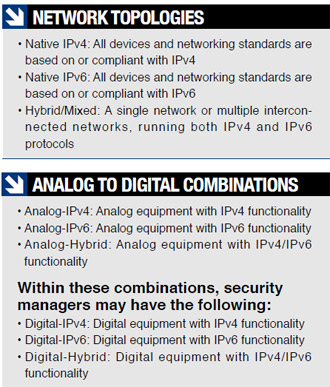As the number of IP addresses runs out, IPv6 adds many more addresses. Edgar Martinez, Senior Technology
Engineer at KBC Networks, examines how this network change affects physical security equipment.
As the number of IP addresses runs out, IPv6 adds many more addresses. Edgar Martinez, Senior Technology Engineer at KBC Networks, examines how this network change affects physical security equipment.
The path to Internet protocol version 6 (IPv6) has been laid out for more than a decade. Yet, as the number of devices connected to IP networks continues to skyrocket — and remaining available IP addresses under the current IPv4 protocol evaporate before our eyes — many organizations will begin the transition to IPv6 in the near future.
This next-generation protocol will provide ample IP addresses for generations to come, to the tune of a ridiculous number which allows the equivalent of roughly 100 unique addresses for every square centimeter on the surface of the Earth. Where you are standing now is equivalent to 370,000 IP addresses. Right now, IPv6 allows allocation of an IP address to every imaginable IP device, from smart phones and surveillance cameras to Internet-connected fridges and even toasters. As a result, the emergence of IPv6 represents a tremendous step in the evolution of IP networks and global communication.
For the physical security industry, the evolution from IPv4 to IPv6 is, in many ways, as significant as the shift from analog video to digital video. Vast networks of cameras — both analog and digital — are being connected to IP networks, and the responsibility of managing those endpoints often falls on the shoulders of IT managers. Fortunately, the advancements of the new protocol will streamline the implementation and management of both native IP and hybrid security networks.
 However, just as the gradual shift from analog to IP security equipment has created “hybrid” networks, the shift from IPv4 to IPv6, which is still in the early stages, will create a different form of hybrid network. In this case, the term “hybrid” describes a combination of multiple protocols. IPv6 was designed to integrate with existing IPv4 networks, which makes it possible to deploy IPv6 in a manner that makes the most sense for the organization undergoing the transition.
However, just as the gradual shift from analog to IP security equipment has created “hybrid” networks, the shift from IPv4 to IPv6, which is still in the early stages, will create a different form of hybrid network. In this case, the term “hybrid” describes a combination of multiple protocols. IPv6 was designed to integrate with existing IPv4 networks, which makes it possible to deploy IPv6 in a manner that makes the most sense for the organization undergoing the transition.
Analog versus Digital In video security applications, it became important to clearly understand an analog versus digital product. Analog equipment never had TCP/IP functionality. As technology changed the industry, products emerged which were labeled “digital.” These digital products were tailored to provide the ability to transition or connect analog equipment to networks. Included during this transition were changes to sensors and access control mechanisms. Integration demanded interoperation and interconnection. For our discussion, we will define “analog” as any source that natively does not support TCP/IP, such as cameras, VCRs and UFOs. The term “digital” applies to any device that does, such as video encoders, decoders, DVRs and NVRs.
Product Adopted:Fiber-Optic Transmission